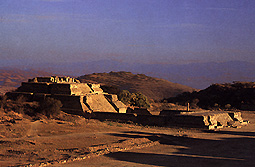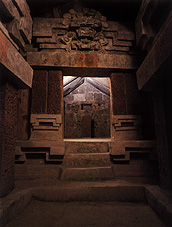
The Mixtecs
The Mixtecs of Postclassic times (10th - 16th c.), lived in three distinct
regions in the state of Oaxaca: the Mixteca Baja in western and
Northwestern Oaxaca, the coastal areas called the Mixteca de la Costa, and
the high, fertile valleys of the Mixteca Alta. It was in the Mixteca Alta
that Mixtec culture reached its highest level of development, and it was
from there that their culture spread into the adjacent Valley of Oaxaca to
co-mingle with the remaining Zapotecs. The Mixtec did not build a major
ceremonial center in the valley, but instead, they occupied many well
known Zapotec cities including Monte Alban, Mitla and yagul. Other lesser
known, but historically important sites of possible Mixtec construction in
this region include Coixtlahuaca and Tilantongo. At all these locations,
the Mixtec developed an extraordinary art style in gold casting and codice
illustration that was to influece all of Mesoamerica throughout the
Postclassic years up to the time of the Spanish Conquest.

Monte Alban
Some of the finest examples of Mixtec craftsmanship were found in 1932, in
Tomb 7 at Monte Alban. The tomb had been built for burial purposes by the
Zapotecs during the Classic Period, and then re-used by the Mixtecs during
the Postclassic time for internment of one of their important leaders.
The ruler who was buried in the tomb was surrounded by a stunning
collection of silver jewelry, rock crystal jewels and vases, and many
different varieties of gold jewelry that had been created by using the
"lost wax" process of gold casting. The Mixtecs had learned the art of
metal casting from the gold workders of Panama and Costa Rica and excelled
in this technique. Using gold, copper, and occasionally silver, they
created an enourmous variety of exquisite jewelry. No finer gold work has
ever been found in the Americas than the beautiful funerary offerings that
were included with the dead leader at Monte Alban.
Although the Mixtec and Zapotec cultures mingled and overlapped in certain
areas of Oaxaca during the Postclassic Period, each had a very individual
development. The Zapotecs remained rooted in their Classic period
religious traditions and the Mixtecs developed a secular rule. The
Mixtecs were more aggresive than the Zapotecs, and they built numerous
defensive sites on mountaintop locations.
Toward the end of the Postclassic period, the Mixtecs banded together with
the remaining Zapotecs to push back the encroaching Aztecs, but
eventually, in the 15th century, the greater part of the Mixtec region
fell to the forces of Tenochtitlan. At this time the Aztec Emperor
Moctezuma conquered the city of Coixtlahuaca, where the richest tributes
in the Mixteca Alta were stored. From that time on, the Mixtec rulers
were allowed to retain their power, but they were required to send their
people to the Aztec capital at tenochtitlan, bearing rich tributes to the
Aztec Kings.




